进程间通信(上)
进程间通信(上)
- 背景
- 进程间通信目的
- 进程间通信发展
- 进程间通信分类
- 管道
- 什么是管道
- 匿名管道
- 实例代码
- 简单的匿名管道实现
- 一个父进程控制单个子进程完成指定任务
- 父进程控制一批子进程完成任务(进程池)
- 用fork来共享管道
- 站在文件描述符角度-深度理解管道
- 站在内核角度-管道本质
- 理解管道操作 -- |
- 管道读写规则
- 管道的特点
- 命名管道
- 原理
- 创建一个命名管道
- 命名管道具体示例
- 命令行创建
- 代码示例
背景
1、进程是具有独立性的,所以进程间想要交互数据,成本会非常高
2、为什么要进行进程间通信?有的时候需要多进程协同处理一件事情。
进程间通信目的
- 数据传输:一个进程需要将它的数据发送给另一个进程
- 资源共享:多个进程之间共享同样的资源。
- 通知事件:一个进程需要向另一个或一组进程发送消息,通知它(它们)发生了某种事件(如进程终止 时要通知父进程)。
- 进程控制:有些进程希望完全控制另一个进程的执行(如Debug进程),此时控制进程希望能够拦截另 一个进程的所有陷入和异常,并能够及时知道它的状态改变。
进程间通信发展
- 管道
- System V进程间通信
- POSIX进程间通信
进程间通信分类
管道
- 匿名管道
- pipe 命名管道
System V IPC(用的不多,更多的是进行本地通信)
- System V 消息队列
- System V 共享内存
- System V 信号量
POSIX IPC(用的较多,也可以用来进行网络通信)
- 消息队列
- 共享内存
- 信号量
- 互斥量
- 条件变量
- 读写锁
注意:System V IPC和POSIX IPC是两套标准(IPC是通信的简称)。
管道
什么是管道
-
管道是Unix中最古老的进程间通信的形式。
-
我们把从一个进程连接到另一个进程的一个数据流称为一个“管道”

匿名管道

里面封装了两次open,第一次是以读方式打开,返回值写在fd[0]中,也就是打开文件的fd,第二次是以写方式打开,返回值写在fd[1]中,也就是打开文件的fd。同时通过上面的联合体标定它是一个管道文件。
#include
功能:创建一无名管道
原型
int pipe(int fd[2]);
参数
fd:文件描述符数组,其中fd[0]表示读端, fd[1]表示写端
返回值:成功返回0,失败返回错误代码-1

实例代码
简单的匿名管道实现
#include
#include
#include
#include
#include
#include
#include
#include
#include
using namespace std;
int main()
{//1.创建管道int pipefd[2] = {0};if(pipe(pipefd) != 0){cerr << "pipe error" << endl;return 1;}//2.创建子进程pid_t id = fork();if(id < 0){cerr << "fork error" << endl;return 2;}else if(id == 0)//子进程{//子进程来读取,关闭写端close(pipefd[1]);
#define MAX_NUM 1024char buffer[MAX_NUM];while(true){memset(buffer, 0, sizeof(buffer));ssize_t ret = read(pipefd[0], buffer, sizeof(buffer) - 1);if(ret > 0){//读取成功,可以进行写入buffer[ret] = '\0';cout << "子进程受到消息了,消息内容:" << buffer << endl;}else if(ret == 0) {sleep(1);//此处是为了稍微等一下父进程cout << "父进程写完了,我也退出了!" << endl;break;}else {//Do nothing}}close(pipefd[0]);exit(0);}else//父进程{//父进程来写入,关闭读端close(pipefd[0]);const string msg = "你好子进程,我是父进程!这次发送的信息编号是: ";int cnt = 0;while(cnt < 5){char sendBuffer[1024];sprintf(sendBuffer, "%s:%d", msg.c_str(), cnt);write(pipefd[1], sendBuffer,strlen(sendBuffer));sleep(1);//为了看现象明显设计的cnt++;}close(pipefd[1]);cout << "父进程写完了" << endl;}pid_t res = waitpid(id, nullptr, 0);if(res > 0){cout << "等待子进程成功!" << endl;}return 0;
}
问:父进程关闭写端了,子进程是如何知道父进程关闭写端的?
答:通过引用计数知道的,file结构体中,有类似引用的变量记录了有几个指针指向该文件。当引用计数为1了,说明此时就只有一个进程指向该文件了。此时子进程读完就不再有进程指向该文件了。
问:父进程每隔一秒写一次,为什么子进程也是一秒读一次呢?
答:当父进程在写入数据的时候,子进程在等(阻塞等待:将当前进程放在等待队列中(管道资源的等待队列中))!所以,父进程写入之后,子进程才能read(会返回)到数据,子进程打印读取数据要以父进程的节奏为主。所以父进程和子进程在读写的时候,是有一定的顺序性的(pipe内部自带访问控制(同步和互斥机制))。(父子进程在各自printf的时候(向显示器写入文件),并没有顺序,谁快谁先写,缺乏访问控制)。
管道内部,没有数据,reader就必须阻塞等待(等管道有数据);管道内部如果被写满了,writer就必须阻塞等待(等数据被读走)。
一个父进程控制单个子进程完成指定任务
代码:
#include
#include
#include
#include
#include
#include
#include
#include
#include
#include
#includeusing namespace std;typedef void(*functor)();
vector functors;//方法集合
//for debug
unordered_map info;
void f1()
{cout << "这是一个处理日志的任务, 执行的进程id:" << getpid() << "执行时间是" << time(nullptr) << endl;;
}
void f2()
{cout << "这是一个备份数据的任务, 执行的进程id:" << getpid() << "执行时间是" << time(nullptr) << endl;;
}
void f3()
{cout << "这是一个处理网络请求的任务, 执行的进程id:" << getpid() << "执行时间是" << time(nullptr) << endl;;
}
void loadFunctor()
{info.insert({functors.size(), "处理日志的任务"});functors.push_back(f1);info.insert({functors.size(), "处理备份数据的任务"});functors.push_back(f2);info.insert({functors.size(), "处理网络请求的任务"});functors.push_back(f3);
}int main()
{//0.加载任务列表loadFunctor();//1.创建管道int pipefd[2] = {0};if(pipe(pipefd) != 0){cerr << "pipe error" << endl;return 1;}//2.创建子进程pid_t id = fork();if(id < 0){cerr << "fork error" << endl;return 2;}else if(id == 0){//3.关闭不需要的文件close(pipefd[1]);//child:read//4.业务处理while(true){uint32_t operatorType = 0;//如果有数据就读取,如果没有数据就阻塞等待,等待任务的到来ssize_t s = read(pipefd[0], &operatorType, sizeof(uint32_t));if(s == 0){cout << "读取数据结束!退出!" << endl;break;}assert(s == sizeof(uint32_t));//assert是断言,是编译有效debug模式//release模式,断言就没有了//如果断言没有了,那么s变量就是只被定义,没有被使用,在release模式中,就会有warning存在(void)s;if(operatorType < functors.size()){functors[operatorType]();}else {cerr << "bug?operatorType = " << operatorType << endl;}}close(pipefd[0]);exit(0);}else if(id > 0){srand((long long)time(nullptr));//3.关闭不需要的文件close(pipefd[0]);//parant:write//4.业务生成int num = functors.size();int cnt = 10;while(cnt--){//5.形成任务码uint32_t commandCode = rand() % num;cout << "父进程指派任务完成,任务是:" << info[commandCode] << ", 任务的编号是:"<< cnt << endl;//向指定的进程下达执行任务的操作write(pipefd[1], &commandCode, sizeof(uint32_t));sleep(1);}close(pipefd[1]);pid_t res = waitpid(id, nullptr, 0);if(res){cout << "wait success" << endl;}}return 0;
}
父进程控制一批子进程完成任务(进程池)
代码:
#include
#include
#include
#include
#include
#include
#include
#include
#include
#include
#includeusing namespace std;typedef void(*functor)();
vector functors;//方法集合
//for debug
unordered_map info;
void f1()
{cout << "这是一个处理日志的任务, 执行的进程id:" << getpid() << "执行时间是" << time(nullptr) << endl << endl;;
}
void f2()
{cout << "这是一个备份数据的任务, 执行的进程id:" << getpid() << "执行时间是" << time(nullptr) << endl << endl;;
}
void f3()
{cout << "这是一个处理网络请求的任务, 执行的进程id:" << getpid() << "执行时间是" << time(nullptr) << endl << endl;;
}
void loadFunctor()
{info.insert({functors.size(), "处理日志的任务"});functors.push_back(f1);info.insert({functors.size(), "处理备份数据的任务"});functors.push_back(f2);info.insert({functors.size(), "处理网络请求的任务"});functors.push_back(f3);
}
//int32_t:进程pid int32_t:该进程对应的管道写端fd
typedef pair elem;
int processNum = 5;//创建子进程的个数
void work(int blockFd)
{ cout << "进程:" << getpid() << "开始工作" << endl;//子进程核心工作的代码while(true){//a.阻塞等待 b.获取任务信息uint32_t operatorCode = 0;ssize_t s = read(blockFd, &operatorCode, sizeof(uint32_t));if(s == 0){break;}assert(s == sizeof(uint32_t));(void)s;//c.处理任务if(operatorCode < functors.size()){functors[operatorCode]();}}cout << "进程:" << getpid() << "结束工作" << endl;
}
//[子进程的pid, 子进程的管道fd]
void BalanceSendTask(vector& processFds)
{srand((long long)time(nullptr));int cnt = 10;//cnt是要分配任务的数目while(cnt != 0){sleep(1);//选择一个进程int pick = rand() % processFds.size();//选择一个任务int task = rand() % functors.size();//把任务给一个指定的进程write(processFds[pick].second, &task, sizeof(int));//打印对应的提示信息cout << "父进程指派任务"<< info[task] << "给进程:" << processFds[pick].first << "编号:" << pick << endl;cnt--;}
}
int main()
{loadFunctor();vector assignMap;//创建processNum个进程for(int i = 0; i < processNum; i++){//定义保存管道fd的对象int pipefd[2] = {0};//创建管道pipe(pipefd);//创建子进程pid_t id = fork();if(id == 0){//子进程读取close(pipefd[1]);//子进程执行work(pipefd[0]);close(pipefd[0]);exit(0);}//父进程做的事情 close(pipefd[0]);elem e(id, pipefd[1]);assignMap.push_back(e);}cout << "creat all process success!" << endl;//父进程派发任务BalanceSendTask(assignMap);//回收资源for(int i = 0; i < processNum; i++){close(assignMap[i].second);}for(int i = 0; i < processNum; i++){if(waitpid(assignMap[i].first, nullptr, 0) > 0){cout << "wait for" << assignMap[i].first << "success!" << "number:" << i << endl;}}return 0;
}
用fork来共享管道
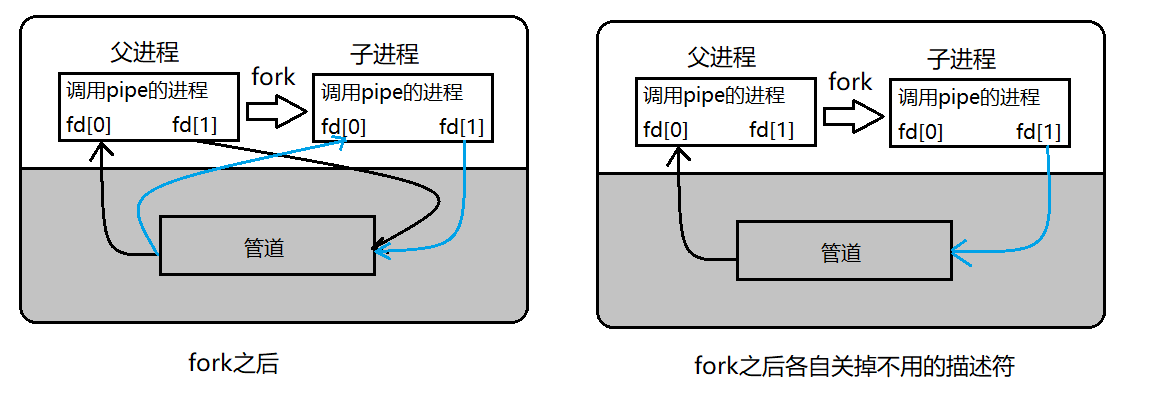
站在文件描述符角度-深度理解管道
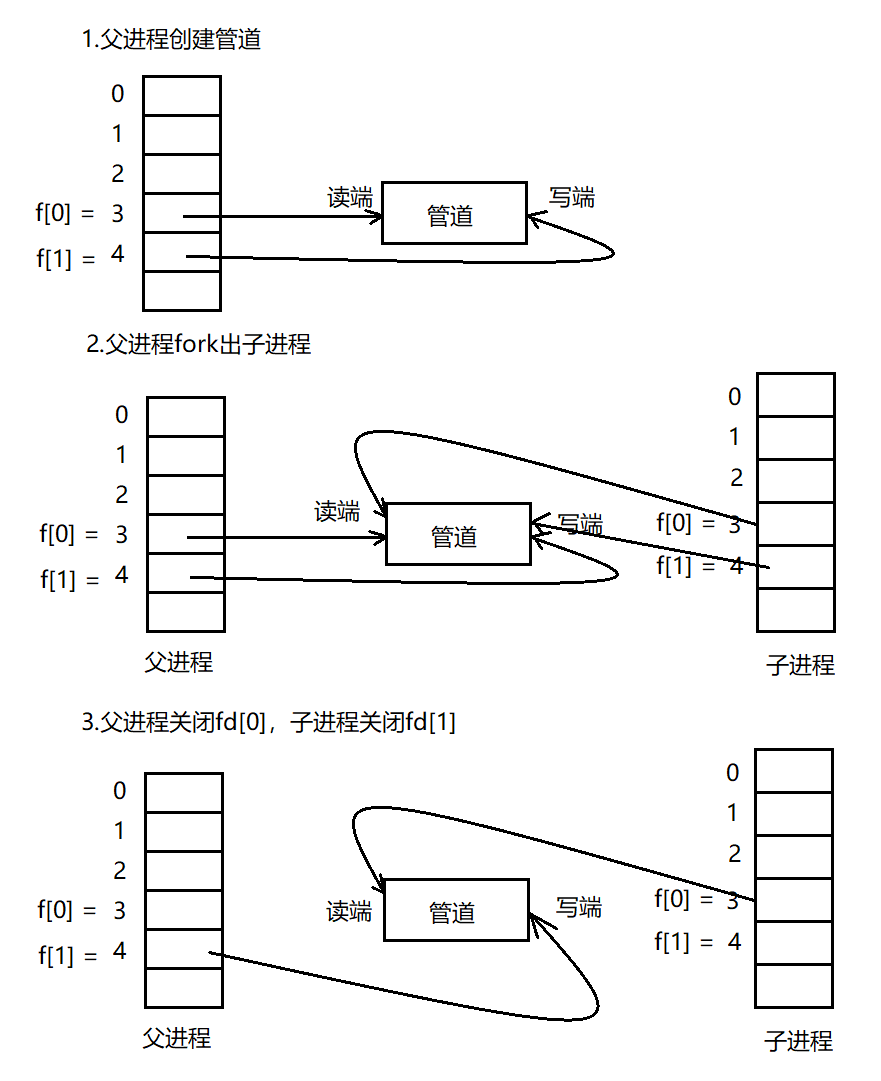
问:为什么父进程要分别打开读和写?
答:为了让子进程继承,让子进程不必再打开了。
问:为什么父子要关闭对应的读和写?
答:因为管道必须是单向通信的,一端是读端,另已端必须是写端。
问:谁决定父子关闭读端还是写端?
答:由需求决定。
站在内核角度-管道本质
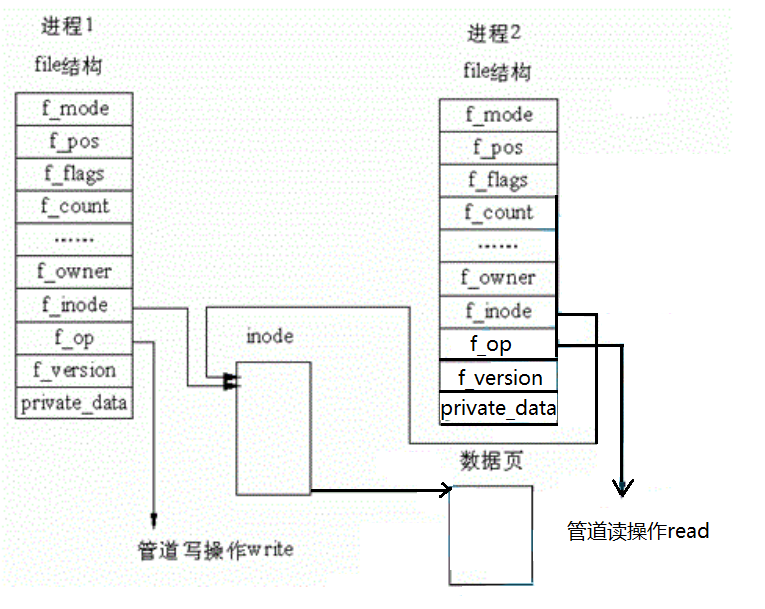
理解管道操作 – |
注意:|操作的本质就是匿名管道。

sleep 1000 | sleep 100
这两个进程(sleep 1000和sleep 100)的关系是什么呢?两个进程的ppid是一样的,即有同样的父进程。
以下面的命令进行举例:
cat pipe.cc | wc -l
父进程fork两个子进程即cat pipe.cc和wc -l,父进程在创建进程的同时,创建了一条匿名管道,两个进程通过该匿名管道来进行通信,cat pipe.cc和wc -l两个进程分别关闭读写端,父进程关闭这个进程的读写端,cat进程进行输出重定向,wc进程进行输入重定向。
管道读写规则
- 当没有数据可读时:
- O_NONBLOCK disable:read调用阻塞,即进程暂停执行,一直等到有数据来到为止
- O_NONBLOCK enable:read调用返回-1,errno值为EAGAIN。
- 当管道满的时候
- O_NONBLOCK disable: write调用阻塞,直到有进程读走数据
- O_NONBLOCK enable:调用返回-1,errno值为EAGAIN
- 如果所有管道写端对应的文件描述符被关闭,则read返回0
- 如果所有管道读端对应的文件描述符被关闭,则write操作会产生信号SIGPIPE,进而可能导致write进程 退出
- 当要写入的数据量不大于PIPE_BUF时,linux将保证写入的原子性。
- 当要写入的数据量大于PIPE_BUF时,linux将不再保证写入的原子性。
管道的特点
- 管道只能用来进行具有血缘关系的进程之间进行进程间通信,常用于父子间通信或者兄弟间通信。(只属于匿名管道)
- 管道只能单向通信(内核实现决定的),半双工的一种特殊情况
- 管道自带同步机制(内核会对管道操作进行同步与互斥)(pipe满,writer等,pipe空,reader等)
- 管道是面向字节流的,先写的字符,一定是先被读取的,没有格式边界,需要用户来定义区分内容的边界
- 管道的生命周期跟随进程 – 管道是文件 – 进程退出了,曾经打开是文件引用计数到达0就会自动退出
命名管道
- 管道应用的一个限制就是只能在具有共同祖先(具有亲缘关系)的进程间通信。
- 如果我们想在不相关的进程之间交换数据,可以使用FIFO文件来做这项工作,它经常被称为命名管道。
- 命名管道是一种特殊类型的文件
原理
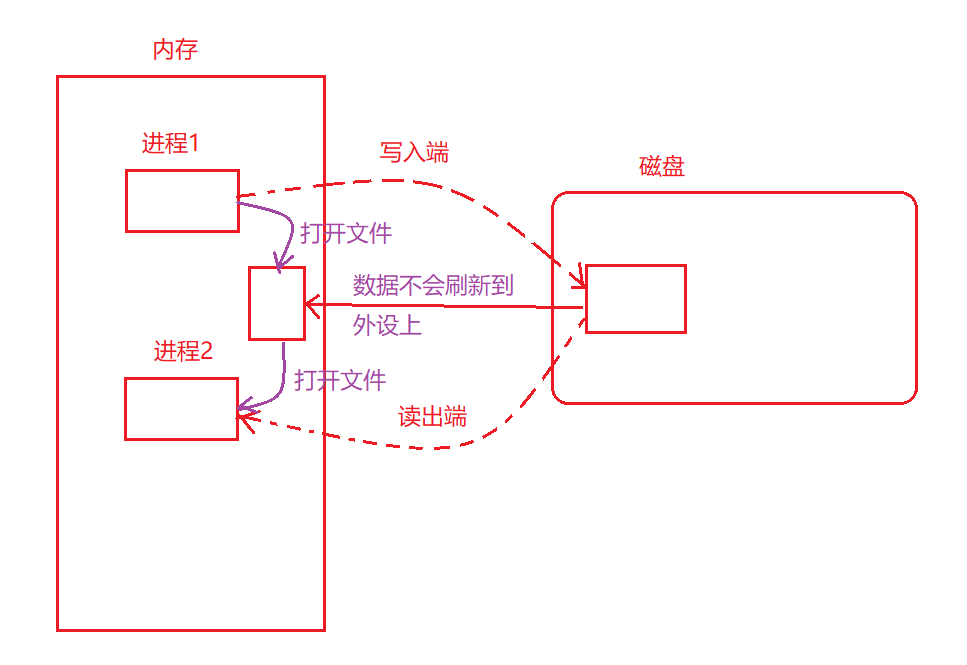
和匿名管道的区别:
匿名管道:子进程继承父进程。
命名管道:通过打开同一个fifo文件,进行信息的交互(路径具有唯一性)
注意:我们使用的命名管道,更多的时候是作为一种标定的作用,内存中的管道文件中的数据不会刷新到磁盘中,即使在进行通信的时候,命名管道的大小也始终是0个字节。
创建一个命名管道
-
命名管道可以从命令行上创建,命令行方法是使用下面这个命令:
$ mkfifo filename -
命名管道也可以从程序里创建,相关函数有:
int mkfifo(const char *filename,mode_t mode);
命名管道具体示例
命令行创建
简单使用:


代码示例
创建管道文件:

删除管道文件:
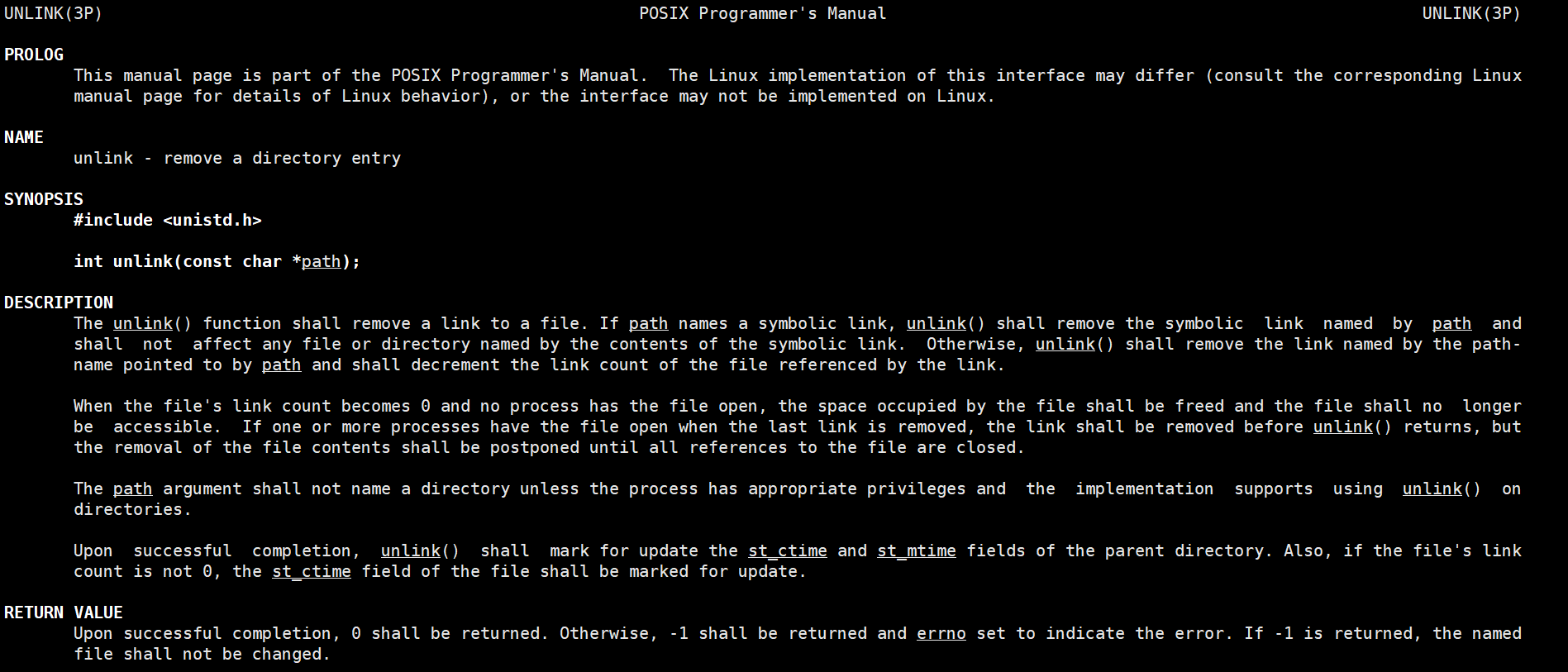
代码示例:
clientFifo.cpp文件:
#include"comm.h"
using namespace std;
int main()
{int pipeFd = open(IPC_PATH, O_WRONLY);if(pipeFd < 0){cerr << "open error" << endl;return 1;}
#define NUM 1024char line[NUM];while(true){printf("请输入你的消息#");fflush(stdout);memset(line, 0, sizeof(line));if(fgets(line, sizeof(line), stdin) != nullptr){line[strlen(line) - 1] = '\0';write(pipeFd, line, strlen(line));//12345\n\0}else {break;}}cout << "退出客户端" << endl;close(pipeFd);return 0;
}
serverFifo.cpp文件:
//写入
#include"comm.h"
using namespace std;
int main()
{if(mkfifo(IPC_PATH, 0666) != 0)//创建管道文件{cerr << "mkfifo error" << endl;return 1;}int pipeFd = open(IPC_PATH, O_RDONLY);if(pipeFd < 0){cerr << "open error" << endl;return 2;}//正常的通信过程
#define NUM 1024char buffer[NUM];while(true){ssize_t s = read(pipeFd, buffer, sizeof(buffer) - 1);if(s > 0){buffer[s] = '\0';cout << "客户端->服务器#" << buffer << endl;}else if(s == 0){cout << "客户退出了,我也退出了!" << endl;break;}else{//do nothingcerr << "read" << strerror(errno) << endl;}}close(pipeFd);cout << "服务端退出了" << endl;unlink(IPC_PATH);//sreturn 0;
}
comm.h文件:
#pragma once
#include
#include
#include
#include
#include
#include
#include
#include
#define IPC_PATH "./.fifo"
makefile文件:
.PHONY:all
all:clientFifo serverFifoclientFifo:clientFifo.cppg++ -o $@ $^ -std=c++11
serverFifo:serverFifo.cppg++ -o $@ $^ -std=c++11
.PHONY:clean
clean:rm -rf clientFifo serverFifo .fifo